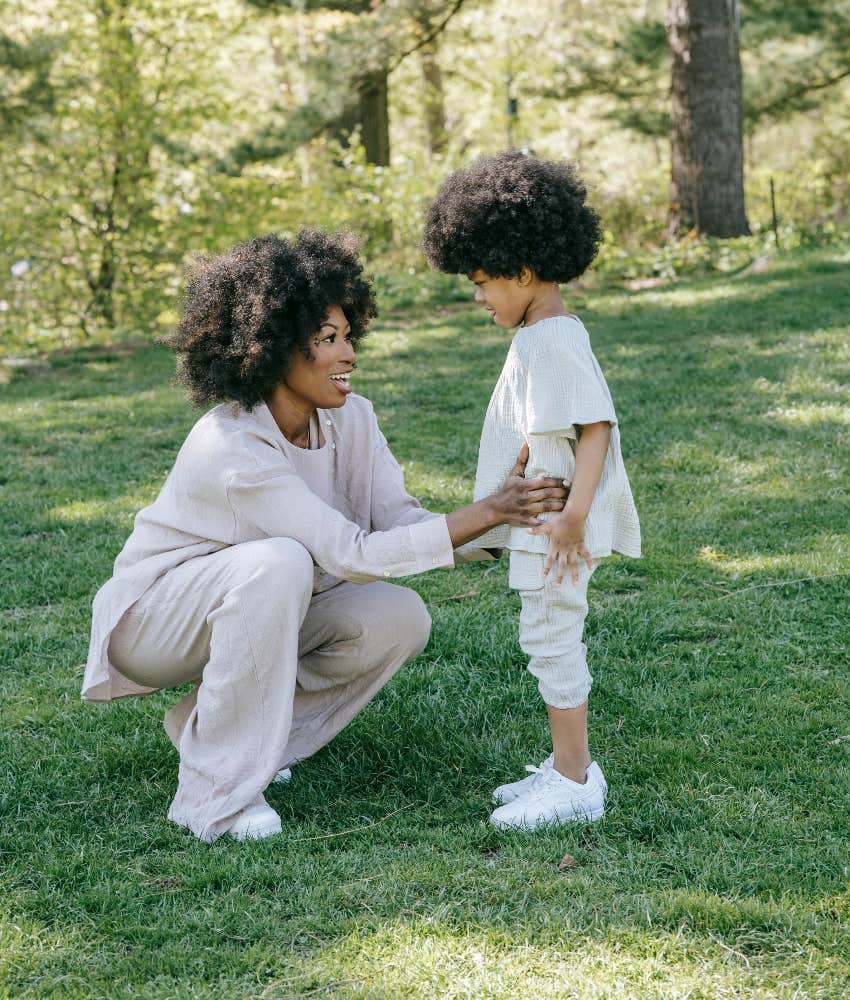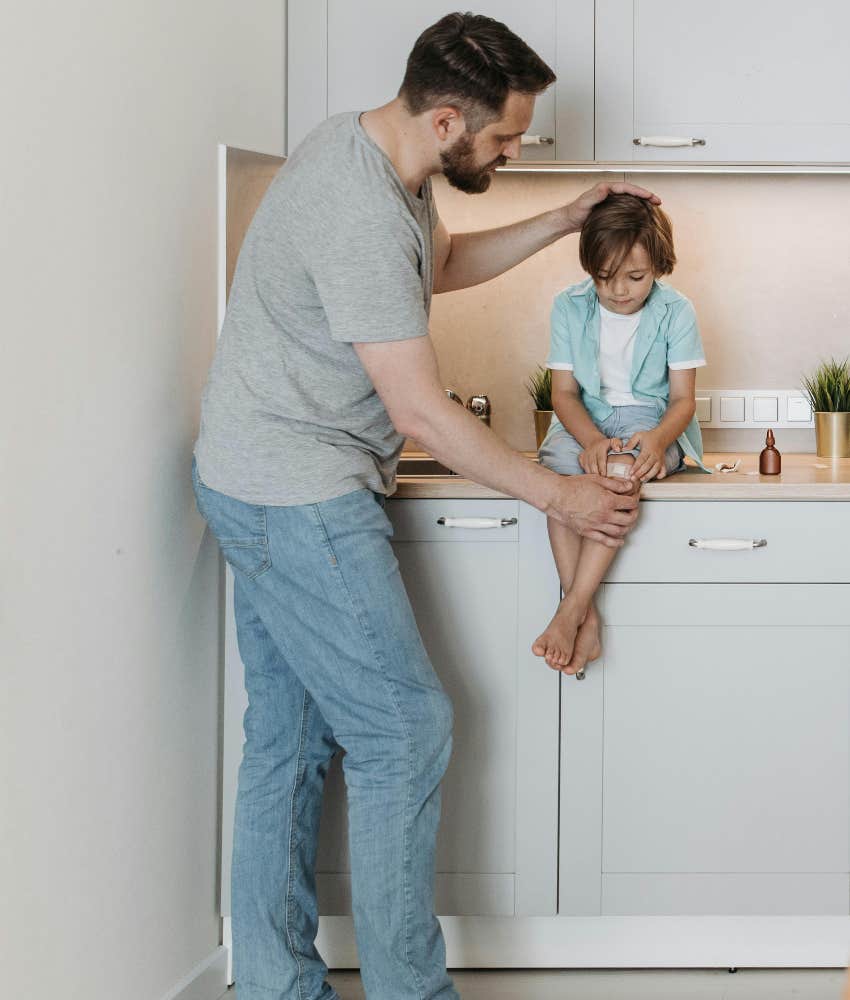Parents Whose Kids Feel Safe Telling Them Everything & Anything Did These 8 Things Right
It's not easy to be automatically trusted by your children, but there are steps you can take to get there.
 fizkes | Shutterstock
fizkes | Shutterstock It’s normal for parents to want their kids to feel safe telling them everything and anything, whether it’s good or bad. Unfortunately for parents, kids don’t often feel comfortable doing that. Divulging their deepest thoughts just doesn’t come naturally when they’re with their parents.
Parents Magazine columnist Alexia Lewis shared her own reasons for not always being completely transparent with her parents. “I assumed they just would not understand or be able to help, so I didn’t want to bother starting a conversation,” she admitted. This is why it’s essential for parents to demonstrate to their kids that they can be trusted, while also showing that they are ready and willing to be helpful. There are several things they can do to facilitate this.
1. Made discussing feelings a regular part of life
 Barbara Olsen | Pexels
Barbara Olsen | Pexels
It’s not always easy to talk about your feelings, no matter how old you are. But for kids to feel like they can share, they must see this as the norm, not the exception. Certified Child-Life Specialist and Licensed Clinical Professional Counselor Kelsey Mora advised, “When we name emotions out loud — both the good and the uncomfortable — we teach our kids that feelings aren’t something to hide.”
Clinical psychologist Katie Davis shared something similar. “One thing that seems abundantly clear in the literature is that social learning is central to emotional development,” she said. “In other words, we develop our ability to understand, express, and regulate our emotions by observing and interacting with others.” Of course, as she added, parents are the most important role models for their children.
Parents who discussed their feelings regularly with their kids weren’t just venting — they were teaching their kids to do the same. This made it easier for their children to open up to them when it was important, and even when it was more mundane.
2. Talked about difficult emotions
It feels easier to just avoid more difficult, painful emotions altogether and stuff them down, but that’s not a healthy way to deal with them. Mora said that when adults don’t talk about a specific topic, it signals to kids that it’s “off limits” and shouldn’t be discussed. Psychologist Pamela Cole, PhD, explained that learning emotional regulation is something that takes time for kids. “Emotion regulation calls on so many skills, including attention, planning, cognitive development, and language development,” she shared.
Because of this, children need to see their parents share their own difficult emotions. It’s the only way they’ll learn to work through them properly. Otherwise, they will just assume that those emotions should be ignored at all costs, which can affect their relationship with their parents and their own self-image. It’s not healthy for anyone to push their emotions down and not experience them.
3. Shared what’s hard for them about being vulnerable
 Kaboompics.com | Pexels
Kaboompics.com | Pexels
As Mora pointed out, a lot of adults don’t really know how to express or share their emotions because it wasn’t allowed when they were growing up. Instead of sticking with this, it can become a teachable moment. “‘I didn’t grow up talking about my feelings, but I want to do that with you — because I know it’s important and helpful,’” she said as an example of a script parents could use when talking to their kids.
Occupational therapist and certified parenting coach Ashley Patek said, “In order to fit into a family system that doesn’t value, honor, or accept unpleasant, hard, shadowy emotions, you survive by not feeling them — or at least by getting really good at not showing them.” This is the opposite of what parents should model for their children, even if it’s what they grew up with. By showing your kids that it’s okay to feel, even when it’s messy, parents signal to them that they can share anything with them.
4. Set the example for sharing
It’s easy to want to force answers out of your kids when asking how their day went, but Mora said a more helpful approach can be to start by sharing your feelings about your own day. Dr. Cole agreed that talking together is the way to go. “When things are calm, find opportunities to talk about feelings and strategies for managing them,” she shared. “It won’t all sink in during one conversation, but you can lay the groundwork.”
When parents show their kids how easy it can be to share emotions and open up, they are teaching them to follow their lead. It helps with emotional regulation and encourages kids to be vulnerable. Kids will follow in their parents’ footsteps to at least some extent, whether they like it or not. That’s why parents setting a good example when it comes to being open about emotions is so important.
5. Made talking about feelings a regular part of their family’s routine
 cottonbro studio | Pexels
cottonbro studio | Pexels
Sharing feelings can feel scary when you’re not used to it. By seamlessly incorporating it into a regular routine, parents show kids that it doesn’t have to be intimidating. Instead, it can be natural. Mora said she does this herself by inviting each family member to share something positive that happened during their day, something negative, and then another positive thing during dinner.
Patek said her family did something similar with “feelings posters.” “It was helpful to notice, recall, and share our authentic selves with each other as a family ritual to rewire my brain and circuit theirs,” she explained. “This felt like a step forward toward breaking generational cycles.”
By making sharing emotions part of your routine, it can become as normal and comfortable for kids as brushing their teeth or making their bed. Having this already built into the day makes it much simpler to share the highs and lows of the day and be open and honest with parents.
6. Didn't just share feelings, but also coping skills
When you’re a parent, it can be tempting to focus all of your energy on making sharing feelings and having open emotions a priority. However, even if your family talks about their feelings, that still leaves a gaping hole that can be filled with coping strategies. Mora said this can be as simple as taking a few shared deep breaths with your child before bed.
“When modeling for your child, talking to them about how and why you use coping strategies can help clarify your intentions,” said Child Mind Institute’s Rosa Klein-Baer. “This is especially true for younger children, who might have a harder time grasping the significance of certain actions without a verbal explanation.”
Parents whose kids feel safe talking to them about their emotions know that it’s not just about sharing feelings and moving on. Instead, it’s important to also teach them how to handle those feelings so they can work through them in a healthy way.
7. Taught kids that there are no bad emotions
 Pavel Danilyuk | Pexels
Pavel Danilyuk | Pexels
It’s easy to fall into the pattern of thinking that happier emotions are good, while ones that don’t make you feel good are bad, but it’s not as simple as that. Emotions aren’t black and white. Rather, they exist on a spectrum. If you teach kids that some feelings are bad, they will think they are supposed to avoid them and not want to discuss them with their parents.
Psychology professor Vanessa LoBue, PhD, said this is especially prominent in Western cultures. She used the Pixar film “Inside Out” as an example, pointing out that Joy is appreciated and extolled, while Sadness is basically stifled. When negative emotions are not given equal time and importance, kids suffer and think they aren’t okay to talk about.
8. Helped kids become emotionally competent
According to LoBue, emotional competence is “how children learn to express and control those emotions and recognize the emotions of others.” Some of this, she said, is biological, but some can also be learned. Although it is simple, repetitive advice, LoBue stated that the best way to develop emotional competence is to talk with your children about their feelings.
It’s important to promote healthy emotions and emotional competence in children, and the best parents know that the number one way to do this is by simply talking. Talking about feelings is, really, probably the most powerful thing a parent can do to help their kids learn how to feel them and process them fully.
It’s not easy to become the parent who kids come to for everything and anything, but by building a strong emotional foundation, you can come one step closer. Having kids feel comfortable coming to you with the good and the bad is all about a feeling of security, and there’s no better way to develop that than to show them that their emotions are valid and understood. This will create a sense of trust that it would be hard to break.
Mary-Faith Martinez is a writer with a bachelor’s degree in English and Journalism who covers news, psychology, lifestyle, and human interest topics.

